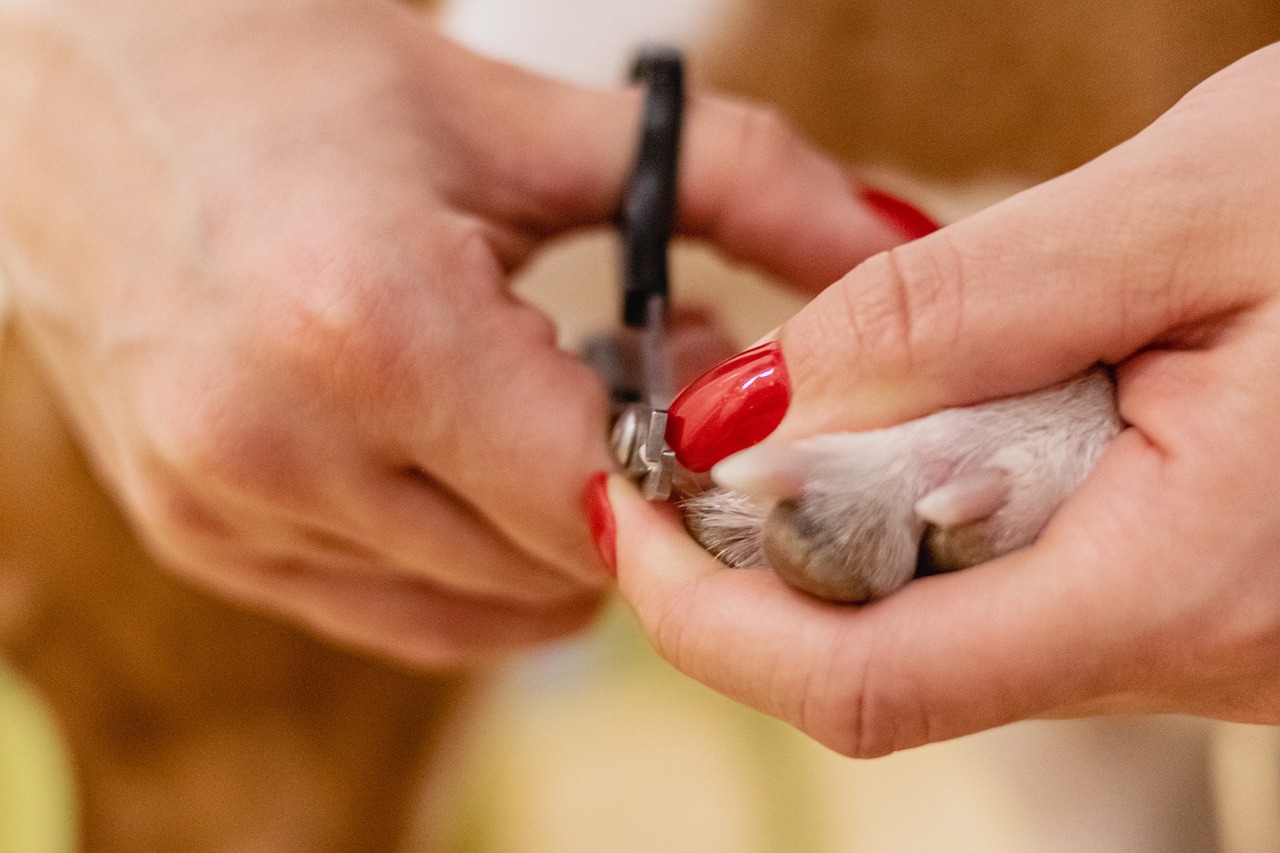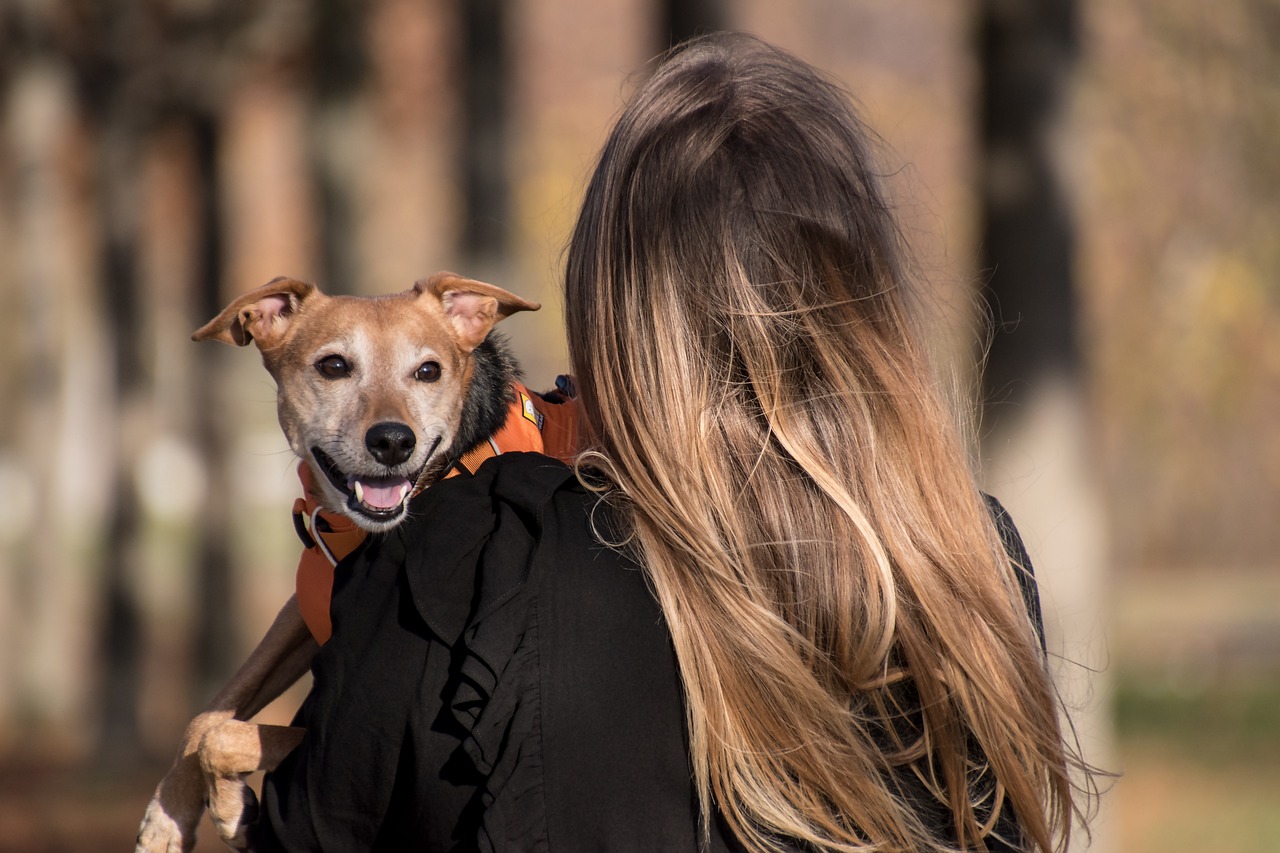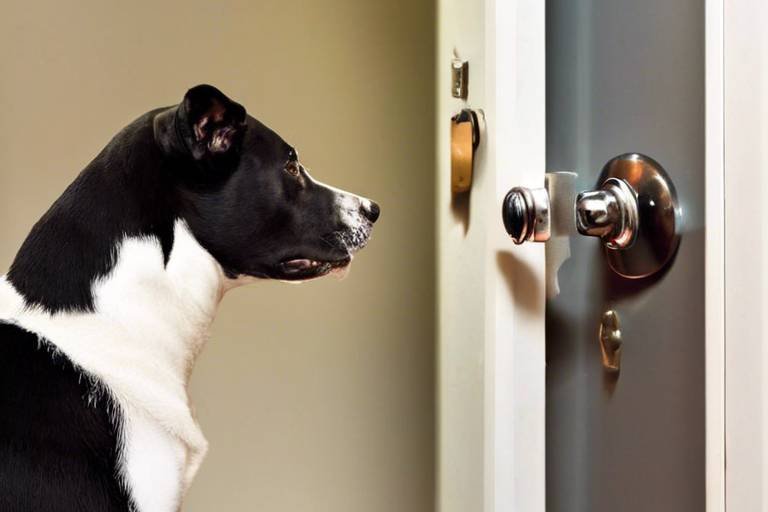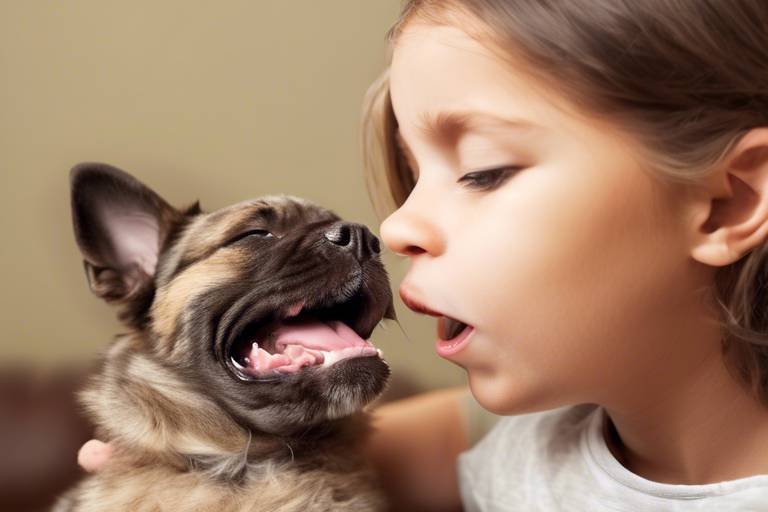How to Help Your Pet Overcome Fear of New People
Have you ever noticed your furry friend cowering behind the couch or barking excessively when a stranger walks through the door? It's heart-wrenching to see our pets struggle with fear, especially when it comes to meeting new people. Just like us, pets can experience anxiety and fear, and this can stem from a variety of reasons such as past trauma, lack of socialization, or even their natural temperament. This article explores effective strategies to help pets deal with their fear of unfamiliar individuals, ensuring a smoother socialization process and enhancing their overall well-being.
Recognizing the root causes of your pet's fear can help you address their anxiety effectively. Fear in pets can manifest in several ways, including hiding, growling, or even aggressive behavior. Some common triggers include:
- Strange sounds (doorbells, loud voices)
- New environments or changes in routine
- Unfamiliar scents
- Past negative experiences with people
Being observant is key! Look for behavioral signs that indicate fear in your pets, such as tail tucking, flattened ears, or wide eyes. Understanding these signs can help you better support your furry friend.
Establishing a secure environment is crucial for your pet's comfort. Imagine having a cozy nook where you can retreat when the world feels overwhelming—this is what a safe space does for your pet. To set up a safe space:
- Choose a quiet area of your home, away from high traffic.
- Include their favorite blanket or bed to make it inviting.
- Add toys or treats to create a positive association.
When your pet feels overwhelmed, they can retreat to this haven, allowing them to regain their composure before facing new situations.
Gradual exposure is a vital method for helping pets acclimate to new individuals. Think of it as introducing a friend to a new game slowly—you wouldn't want to overwhelm them right away! Here’s how to do it step-by-step:
- Start with a controlled environment where your pet feels safe.
- Introduce a calm and friendly person who understands your pet's fear.
- Allow your pet to approach at their own pace, rewarding them for any brave steps they take.
This method helps your pet build confidence without the pressure of sudden interactions.
Controlled introductions can ease the anxiety of meeting new people. It’s like having a warm-up before a big game! Here’s how to manage these encounters effectively:
- Keep the initial meetings short and sweet.
- Use a leash to maintain control while allowing your pet to explore.
- Encourage the new person to ignore your pet until they approach.
By setting the stage for positive experiences, you're paving the way for your pet to feel more comfortable around new individuals.
Using positive reinforcement can significantly improve your pet's response to new people. Just like we thrive on praise, pets do too! Reward your pet with treats, praise, or playtime whenever they exhibit calm behavior around new individuals. This encourages them to associate new people with good things, making them less fearful over time.
Engaging in socialization exercises is essential for building your pet's confidence. Think of these activities as fun training sessions that help your pet learn to navigate the social world. Here are a couple of ideas:
Organizing playdates with well-mannered dogs can help your pet learn social cues. Dogs are social animals, and a friendly buddy can show your pet that meeting new friends can be a blast! Make sure the other dog is calm and friendly, as this will create a positive experience for your pet.
Group training classes offer structured environments for socialization. These classes are perfect for teaching your pet to interact with both people and other pets in a controlled setting. Plus, they provide an opportunity for you to learn effective techniques to help your pet thrive.
Tracking your pet's progress is vital for understanding their development. Keep a journal of their reactions to new people and note any improvements. Celebrate the small victories, whether it's a wagging tail or a curious sniff. This will help you stay motivated and adjust your strategies as needed.
If your pet's fear persists, professional assistance may be necessary. Sometimes we all need a little extra help! Consult a veterinarian or animal behaviorist for tailored support and strategies. They can provide insights into your pet's behavior and help you create a customized plan to ensure your pet feels secure and confident.
Q: How long does it take for my pet to overcome their fear?
A: Every pet is different, so the timeline can vary. With consistent practice and patience, many pets show improvement within weeks to months.
Q: What if my pet reacts aggressively to new people?
A: It's essential to consult a professional if aggression is a concern. They can help you develop a safe and effective plan to manage your pet's behavior.
Q: Can I use calming products to help my pet?
A: Yes! There are various calming products available, such as pheromone diffusers or anxiety wraps. However, these should be used in conjunction with behavioral training.

Understanding Your Pet's Fear
When it comes to our furry friends, understanding their fears can feel like trying to solve a complex puzzle. Pets, just like humans, can experience anxiety and fear, especially when confronted with new people. But what exactly triggers this fear? It’s essential to recognize that the roots of fear can vary widely among different pets, influenced by factors such as their past experiences, genetics, and even their breed. For instance, a rescue dog who had a rough start may be more apprehensive than a dog raised in a loving home from puppyhood.
Common triggers for fear in pets include:
- Strange noises: Loud sounds or unfamiliar environments can send a pet into a tailspin of anxiety.
- Unfamiliar scents: Pets have an acute sense of smell, and new odors can be overwhelming.
- New people: The sight, sound, and even the energy of unfamiliar humans can be intimidating.
- Past trauma: A history of negative experiences can lead to long-lasting fears.
Behavioral signs of fear can manifest in various ways. Some pets may hide or try to escape, while others might bark, growl, or even show signs of aggression. It's crucial to pay attention to your pet's body language. For example, a tucked tail, flattened ears, or a lowered head are all indicators that your pet is feeling anxious. Understanding these signs can help you intervene before their fear escalates into more severe anxiety.
Moreover, consider how your pet's breed may influence their reaction to new people. For instance, breeds known for their protective instincts, like German Shepherds, might be more wary of strangers than breeds that are naturally more social, like Golden Retrievers. This doesn’t mean that one breed is better than the other; it simply highlights the importance of recognizing individual differences when it comes to handling your pet's fear.
In summary, understanding your pet's fear involves a combination of recognizing triggers, observing behavioral signs, and considering their unique background. By taking the time to learn about what makes your pet tick, you can begin to formulate a plan to help them overcome their fears and lead a more confident, happy life.

Creating a Safe Space
Creating a safe space for your pet is like building a cozy nook where they can unwind and feel secure. Imagine coming home after a long day, and instead of the chaos of the outside world, you have a little haven waiting just for you. This is what your pet needs—a sanctuary where they can retreat when the world feels too overwhelming, especially when new people come into the picture.
To establish this safe space, start by choosing a quiet area in your home that is away from the hustle and bustle. This could be a corner of your living room, a spare room, or even a cozy spot in your bedroom. The key is to make it a place that feels comfortable and familiar to your pet. You can enhance this environment by adding their favorite blanket, toys, or even a piece of your clothing. The familiar scents will help them feel more at ease.
Next, consider the physical setup of this space. A crate can serve as a fantastic safe haven, provided it’s introduced in a positive manner. Make it inviting by adding soft bedding and toys. If your pet doesn’t like crates, a simple bed or a pet-friendly corner with a few cushions can also do the trick. Ensure that this space has a clear boundary, so your pet knows it is their own little territory. You might even want to use a baby gate to create a safe zone that keeps new people at a distance while still allowing your pet to observe from afar.
It's also important to keep this area free from any stressors. Avoid placing it near loud appliances or high-traffic areas in your home. The goal is to create an environment that feels calming. You can use calming aids like pheromone diffusers or soft music to further soothe your pet when they’re feeling anxious.
To reinforce the idea that this space is a safe haven, encourage your pet to use it regularly. You can do this by rewarding them with treats or affection when they choose to go there on their own. This positive reinforcement will help them associate the space with comfort and security. Remember, the more they feel that this area is a sanctuary, the more confident they will become in facing new experiences, including meeting new people.
Lastly, it’s vital to respect your pet’s need for solitude. If they retreat to their safe space, allow them to stay there until they feel ready to come out. Forcing them into social situations before they are ready can lead to increased anxiety and fear. By giving your pet the freedom to choose when to engage, you empower them and build their confidence over time.
- How can I tell if my pet feels safe in their space? Look for signs of relaxation, such as lying down comfortably, playing with toys, or even napping. If your pet spends time there voluntarily, it’s a good sign they feel secure.
- What should I do if my pet refuses to use their safe space? Try to make the space more inviting with familiar items and spend time near it with them. Gradually encourage them to explore it without pressure.
- Is it okay to use a crate as a safe space? Yes, as long as the crate is introduced positively and is never used as a form of punishment. It should be a place your pet associates with comfort and safety.

Gradual Exposure Techniques
When it comes to helping your pet overcome their fear of new people, gradual exposure is one of the most effective techniques you can employ. Think of it as a gentle introduction to the world outside their comfort zone. Just like a child learning to swim, your pet needs to ease into the water rather than be thrown in the deep end. This method is all about taking baby steps, ensuring that each encounter with unfamiliar individuals is a positive experience.
Start by identifying a few low-stress situations where your pet can meet new people without feeling overwhelmed. For example, consider inviting a calm friend over who understands your pet's anxiety. This friend can help create a relaxed atmosphere, which is crucial for your pet's first interactions. Remember, the goal is to make these encounters as stress-free as possible, so choose individuals who are patient and willing to give your pet the space they need.
During these initial meetings, it's essential to maintain a distance that feels safe for your pet. If your pet is nervous, don't force them to approach the new person. Instead, allow them to observe from a distance. You can gradually decrease this distance over time as your pet becomes more comfortable. This is where the magic of positive reinforcement comes into play. Each time your pet behaves calmly in the presence of new people, reward them with treats or praise. This will help them associate new individuals with positive experiences.
As your pet gains confidence, you can start incorporating more challenging scenarios. For instance, you might organize small gatherings with a few friends or family members. Ensure that these people are aware of your pet's fears and know how to interact with them gently. Encourage your guests to ignore your pet at first, allowing them to approach on their own terms. This approach can help your pet feel more in control and reduce their anxiety.
To track your progress, consider keeping a journal of your pet's experiences. Documenting each introduction, how your pet reacted, and the rewards you used can provide valuable insights into what works best for your furry friend. This not only helps you see improvements over time but also allows you to adjust your strategies as needed.
Finally, be patient! Every pet is unique, and some may take longer than others to adjust to new people. Celebrate the small victories along the way, and don't hesitate to revisit earlier steps if your pet seems to regress. Remember, the journey to overcoming fear is just as important as the destination.
- How long does it take for a pet to overcome their fear? Each pet is different; some may adjust quickly, while others may need weeks or even months. Consistency and patience are key.
- Can I use toys as a distraction during introductions? Absolutely! Toys can help divert your pet's attention and create a more relaxed environment during the introduction.
- What should I do if my pet becomes aggressive towards new people? If your pet exhibits aggressive behavior, it's crucial to stop the introduction immediately and consult with a professional trainer or behaviorist.
Controlled Introductions
Introducing your pet to new people can be a daunting task, especially if your furry friend is prone to anxiety. However, with , you can create a positive experience that helps your pet feel more comfortable around unfamiliar faces. The key here is to take things slow and ensure that each encounter is as stress-free as possible. Think of it like teaching a child to ride a bike; you wouldn't just push them off and hope for the best, right? You’d start with training wheels and gradually remove them as they gain confidence. The same principle applies to our pets.
Start by choosing a calm and quiet environment for the introduction. This could be your home or a familiar outdoor space that isn’t too crowded. The goal is to minimize distractions and keep your pet focused on the task at hand. Once you’ve set the stage, it’s time to bring in the new person. Here are some steps to follow:
- Keep Distance: When the new person arrives, maintain a comfortable distance between them and your pet. This distance should be far enough that your pet feels safe but close enough for them to see the new person.
- Use a Leash: For added control, use a leash. This not only helps you manage your pet's movements but also gives them a sense of security, knowing they can’t run away if they feel overwhelmed.
- Engage in Calm Activities: Encourage the new person to engage in calm and non-threatening activities, such as sitting quietly or tossing treats towards your pet. This can help your pet associate the new person with positive experiences.
- Observe Body Language: Pay close attention to your pet’s body language. Signs of fear may include tucked tails, flattened ears, or avoidance behavior. If your pet seems uncomfortable, take a step back and give them more space.
As your pet becomes more comfortable, gradually decrease the distance between them and the new person. This process can take time, so be patient and allow your pet to set the pace. Remember, every small victory counts! If your pet approaches the newcomer or sniffs them, offer plenty of praise and rewards. Positive reinforcement is crucial in helping your pet build trust.
To further enhance the experience, consider using a reward system. For instance, you can prepare a small treat bag filled with your pet's favorite snacks. Each time your pet displays calm behavior around the new person, reward them with a treat. This will not only reinforce good behavior but also create a positive association with new individuals.
In summary, controlled introductions are a gradual process that requires patience and understanding. By setting the stage for success, observing your pet's reactions, and using positive reinforcement, you can help your pet overcome their fear of new people. Just like building a strong bridge, it takes time and careful construction, but the end result is worth it—a more confident and sociable pet!
- How long should I wait before introducing my pet to new people? It depends on your pet's comfort level. Start with a few minutes at a distance and gradually increase the time as they become more comfortable.
- What if my pet shows signs of aggression during introductions? If your pet displays aggressive behavior, it’s best to back off and give them space. Consult a professional trainer or behaviorist for tailored strategies.
- Can I use toys during introductions? Yes! Toys can be a great way to distract your pet and create a fun atmosphere. Just ensure they’re not too excited or overstimulated.
Positive Reinforcement
When it comes to helping your pet overcome their fear of new people, plays a pivotal role. This technique involves rewarding your pet for calm behavior, which helps them associate unfamiliar individuals with positive experiences rather than stress. Imagine if every time you encountered something scary, someone handed you a cookie. Wouldn’t that make you feel a bit better about the situation? That’s the essence of positive reinforcement!
To effectively implement this strategy, you need to identify what motivates your pet the most. Is it tasty treats, a favorite toy, or perhaps some extra belly rubs? Once you know what your pet loves, you can use these rewards to encourage them to face their fears. For instance, when a new person enters your home, you can start by giving your pet a treat while they remain calm. This creates a direct link between the presence of new people and something enjoyable, gradually helping to alleviate their anxiety.
Here are a few tips to make positive reinforcement work effectively:
- Timing is Everything: Reward your pet immediately when they display calm behavior around new people. This helps them connect the dots between their actions and the reward.
- Consistency is Key: Ensure that everyone in your household uses the same cues and rewards. Consistency will reinforce your pet’s learning.
- Gradual Steps: Start with less intimidating situations, such as having a friend visit who your pet is familiar with, and gradually introduce more challenging scenarios.
Additionally, it’s crucial to remain patient. Some pets may take longer to adjust than others, and that's perfectly okay! Celebrate the small victories, whether it's your pet approaching a new person or simply staying calm in their presence. By consistently using positive reinforcement, you’ll be amazed at how your pet’s confidence grows over time.
In conclusion, positive reinforcement is not just about treats; it’s about building trust and confidence in your pet. As they learn to associate new people with good things, you’ll see their fears diminish and their social skills flourish. Remember, every little step counts, and your encouragement will pave the way for a more confident and happy pet!
Q1: How long will it take for my pet to overcome their fear?
A1: The timeline varies for each pet. Some may show improvement in a few weeks, while others may take several months. Patience and consistency are crucial.
Q2: Can I use positive reinforcement with all types of pets?
A2: Yes, positive reinforcement can be effective for most pets, including dogs, cats, and even some small animals. Tailor your approach to suit your pet's unique personality.
Q3: What if my pet doesn’t respond to treats?
A3: If treats aren’t motivating, consider other rewards like praise, playtime, or favorite toys. Discover what excites your pet and use that as a reward.

Socialization Exercises
When it comes to helping your pet overcome their fear of new people, are an essential part of the journey. Just like humans, pets benefit from engaging in activities that help them build confidence and learn how to interact with others. Think of it as a fun training camp where your furry friend can learn the ropes of social behavior while having a blast!
One of the most effective ways to introduce your pet to new people is through structured activities that encourage positive interactions. These exercises not only help your pet get used to unfamiliar faces but also create a positive association with social situations. For instance, consider organizing playdates with calm dogs. This approach allows your pet to engage with other dogs in a controlled setting, where they can observe and mimic appropriate social behaviors. It's like having a buddy system where they can learn from their peers!
Another fantastic option is enrolling your pet in group training classes. These classes provide a structured environment that is perfect for socialization. Not only will your pet learn valuable skills, but they will also be surrounded by other animals and people, which can help normalize the presence of new individuals. Imagine your pet strutting their stuff in a classroom full of friendly faces—what a confidence booster!
During these socialization exercises, it's crucial to monitor your pet's reactions. Pay attention to their body language; signs of stress or discomfort may indicate that you need to take a step back. Gradually increase the level of exposure based on your pet's comfort level. You might even consider keeping a socialization journal to track their progress. This journal can include details like:
| Date | Activity | Reactions | Notes |
|---|---|---|---|
| 01/01/2023 | Playdate with Max | Curious, but hesitant | Gave treats to encourage interaction |
| 01/05/2023 | Group Training Class | Relaxed, engaged | Participated well with other pets |
As your pet becomes more comfortable with these exercises, you can gradually introduce them to more challenging social situations. Remember, the goal is to create a positive experience that helps them feel safe and secure around new people. With patience, love, and a bit of creativity, you can transform your pet's fear into confidence, turning every new encounter into an opportunity for growth.
Q: How long will it take for my pet to overcome their fear of new people?
A: The timeline varies for each pet, but with consistent practice and patience, you can expect to see improvements within weeks to months.
Q: What should I do if my pet reacts negatively during a socialization exercise?
A: If your pet shows signs of distress, it's important to take a step back and allow them to calm down. Gradually reintroduce them to the situation at their own pace.
Q: Are there specific breeds that are more prone to fear of new people?
A: While any pet can develop fears, some breeds are naturally more cautious or reserved. Understanding your pet's breed tendencies can help tailor your approach.
Q: Can I use treats during socialization exercises?
A: Absolutely! Using treats can create positive associations with new experiences. Just be sure to use them sparingly and in moderation.
Playdates with Calm Dogs
Organizing can be a game-changer for your pet's socialization journey. Think of it as a gentle introduction to the world of canine companionship. When your pet interacts with a well-mannered dog, it not only helps them learn social cues but also allows them to observe how other dogs react to new situations. This can be incredibly beneficial, especially for pets who are naturally anxious or fearful around unfamiliar individuals.
Before setting up a playdate, it's important to choose the right dog. Look for a dog that is known to be calm, friendly, and well-socialized. This dog should have a good track record of interacting with other pets and should exhibit a relaxed demeanor. By surrounding your pet with a positive role model, you can help them feel more at ease. It’s like having a buddy who shows them the ropes in a new environment!
When planning the playdate, consider the following tips to ensure a smooth experience:
- Neutral Territory: Choose a neutral location for the playdate, such as a local park or a pet-friendly yard. This helps prevent territorial behavior from either dog.
- Short Sessions: Start with short play sessions to avoid overwhelming your pet. Gradually increase the duration as they become more comfortable.
- Supervision: Always supervise the playdate to ensure that both dogs are behaving well. If you notice any signs of stress or discomfort, be ready to intervene.
During the playdate, observe how your pet interacts with the other dog. Look for signs of playfulness, such as wagging tails and relaxed body language. If your pet seems hesitant or scared, don’t force interactions. Instead, allow them to approach the other dog at their own pace. This is crucial for building their confidence. Remember, patience is key!
After the playdate, take some time to reflect on the experience. Was your pet more relaxed than before? Did they engage in play? Keeping track of these observations will help you understand what works best for your pet and how they are progressing in their socialization journey. You might even consider keeping a socialization journal to document your pet's experiences and improvements over time.
In summary, playdates with calm dogs can provide a supportive environment for your pet to learn and grow. By carefully selecting the right playmate and creating a positive experience, you can help your furry friend overcome their fears and become more comfortable around new individuals. It's all about taking those small, manageable steps toward a more confident and socialized pet!
Q: How often should I schedule playdates for my pet?
A: It depends on your pet's comfort level. Start with once a week and adjust based on their progress and enthusiasm.
Q: What if my pet doesn't seem to enjoy playdates?
A: Every pet is different. If your pet shows signs of stress or disinterest, it might be best to take a break and try again later or with a different dog.
Q: Can playdates help with other behavioral issues?
A: Yes! Socialization can help reduce anxiety and fear, making your pet more adaptable in various situations.
Group Training Classes
Group training classes can be a game changer for pets struggling with fear of new people. Imagine a bustling room filled with friendly faces, wagging tails, and the sound of laughter. This environment can be overwhelming for a shy pet, but it also offers a unique opportunity for growth. By enrolling your furry friend in group classes, you're not just teaching them commands; you're providing them with a chance to socialize and build confidence in a controlled setting.
These classes typically involve a variety of exercises that encourage interaction with both humans and other pets. The structured format helps create a sense of safety and predictability, which is essential for anxious animals. In these classes, your pet can learn to associate new people with positive experiences, which is crucial for overcoming their fear. Just think of it as a social playground where your pet can learn the ropes of doggy etiquette while feeling supported.
Moreover, group training classes often focus on positive reinforcement, rewarding pets for calm behavior and successful interactions. This approach not only reinforces good behavior but also helps to build a positive association with unfamiliar individuals. As your pet begins to feel more comfortable, you'll likely notice them becoming more engaged and relaxed during these sessions.
When considering a group training class, look for options that cater specifically to dogs with anxiety issues. Some key features to look for include:
- Small Class Sizes: A smaller group allows for more individual attention, which can be less intimidating for your pet.
- Experienced Instructors: Trainers who understand animal behavior can provide tailored strategies to help your pet thrive.
- Positive Environment: Classes that emphasize encouragement and support create a safe space for your pet to learn.
As your pet progresses through the classes, you'll likely see a transformation in their behavior. They may start to approach new people with curiosity rather than fear, and their tail might wag in excitement instead of tucking between their legs. It's not just about overcoming fear; it's about building a bond of trust between you and your pet, which can lead to a happier, more confident companion.
In summary, group training classes serve as an excellent platform for socialization, offering both you and your pet the tools needed to navigate the world of new people. With patience and consistency, these classes can help your furry friend blossom into a well-adjusted, sociable pet who is ready to face the world with confidence.
Q: How long does it take for my pet to get used to new people?
A: The timeline varies for each pet. Some may adjust in a few weeks, while others may take several months. Consistent exposure and positive experiences are key.
Q: Can I attend the class with my pet?
A: Yes, most group training classes encourage owners to participate actively, which helps strengthen the bond between you and your pet.
Q: What if my pet doesn't respond well in a group setting?
A: If your pet shows extreme anxiety, it may be beneficial to consult with a professional trainer or behaviorist to develop a tailored approach.

Monitoring Progress
Keeping track of your pet's progress is essential for understanding how well they are adapting to new people. Just like humans, pets can experience fluctuations in their comfort levels, and being observant can help you recognize patterns in their behavior. Monitoring progress isn't just about noting improvements; it's also about identifying setbacks and adjusting your approach accordingly. So, how can you effectively monitor your pet's journey?
One effective method is to maintain a behavior journal. This journal can serve as a detailed record of your pet's interactions with new people, capturing their reactions, body language, and overall demeanor. For instance, you might note instances where your pet displayed signs of fear, such as trembling, hiding, or barking, as well as moments of calmness or curiosity. By creating a timeline of these behaviors, you can better understand the situations that trigger anxiety and those that elicit positive responses.
To make this process easier, consider using a simple table format to summarize your observations. Here’s a quick example:
| Date | New Person Encountered | Behavior Observed | Response Level (1-10) |
|---|---|---|---|
| 2023-10-01 | Neighbor | Trembling, hiding behind owner | 2 |
| 2023-10-05 | Friend | Sniffing, wagging tail | 6 |
| 2023-10-10 | New Dog Walker | Calm, approached cautiously | 8 |
This table not only helps you visualize your pet's progress but also serves as a motivational tool. When you see an upward trend in their response levels, it can be incredibly rewarding. Remember, the goal is to celebrate small victories. Even a slight increase in comfort or a new positive behavior can be a significant step forward.
Additionally, consider incorporating regular check-ins with your pet. This can be as simple as observing their body language around unfamiliar people or noticing how quickly they recover from stressful encounters. Are they taking longer to settle down than before? Or perhaps they’re showing more curiosity? These subtle changes can provide valuable insights into their emotional state.
Finally, don’t hesitate to involve other family members or friends in this monitoring process. They can provide different perspectives on your pet's behavior during interactions, which can be incredibly helpful. After all, the more eyes on the situation, the better understanding you will have of your pet's progress.
- How long does it take for a pet to overcome their fear of new people? - The timeline varies by individual pet, but with consistent training and patience, many pets can show improvement within weeks to months.
- What are some signs that my pet is making progress? - Look for behaviors such as approaching new people, decreased barking, or a relaxed body posture.
- Should I force my pet to interact with new people? - No, forcing interactions can increase fear. It's essential to allow your pet to approach at their own pace.

Seeking Professional Help
Sometimes, despite our best efforts, our beloved pets may still struggle with fear and anxiety around new people. If you notice that your pet's fear is not improving or is getting worse, it might be time to seek professional help. Consulting a veterinarian or an animal behaviorist can provide you with tailored strategies that are specifically designed to address your pet's unique needs.
Veterinarians can rule out any underlying medical issues that might be contributing to your pet's anxiety. For instance, pain or discomfort can sometimes manifest as fear or aggression. Once any health concerns are addressed, they may recommend a behaviorist or suggest medications that can help ease your pet's anxiety during the training process.
Animal behaviorists specialize in understanding the intricacies of pet behavior and can offer valuable insights into your pet's fears. They can develop a customized behavior modification plan that includes techniques such as desensitization and counter-conditioning. These methods gradually expose your pet to their fears in a controlled manner, helping them to adjust at their own pace.
Before you decide on a professional, consider the following factors:
- Credentials: Ensure the professional has the necessary qualifications and experience in handling fear-based behaviors.
- Approach: Look for someone who uses positive reinforcement techniques rather than aversive methods.
- Reviews: Seek recommendations from other pet owners or read online reviews to gauge the effectiveness of their methods.
When you do reach out for help, be prepared to share detailed observations about your pet's behavior. This information will be crucial for the professional to create an effective plan. Remember, seeking help is not a sign of failure; rather, it shows your commitment to your pet's well-being and happiness!
In conclusion, while tackling fear in pets can be challenging, you don’t have to do it alone. Professional guidance can make a significant difference, providing you and your pet with the tools needed to navigate social situations more comfortably. After all, a confident pet is a happy pet!
Here are some common questions pet owners have when dealing with their pets' fear of new people:
- How do I know if my pet needs professional help? If your pet shows signs of extreme fear, aggression, or if their anxiety interferes with daily activities, it's time to consult a professional.
- What can I expect from a consultation? A professional will assess your pet's behavior and provide a tailored plan that may include training techniques, behavioral modification, and possibly medication.
- Is medication a good option for my pet? Medication can be beneficial in certain cases, particularly for severe anxiety. A veterinarian can help determine if this is necessary.
- How long will it take to see improvements? Each pet is different, but with consistent training and support, you should start to see progress within a few weeks to months.
Frequently Asked Questions
- What are the common signs that my pet is afraid of new people?
Pets may exhibit various signs of fear, such as hiding, barking, growling, or even trembling when they encounter unfamiliar individuals. Other behaviors include avoiding eye contact, cowering, or trying to escape the situation. Recognizing these signs is crucial for addressing their anxiety effectively.
- How can I create a safe space for my pet?
Creating a safe space involves designating a quiet area in your home where your pet can retreat when feeling overwhelmed. This space should be comfortable and familiar, filled with their favorite toys and bedding. Consider using a crate or a cozy corner that’s away from the hustle and bustle, allowing your pet to feel secure and relaxed.
- What is gradual exposure and how do I implement it?
Gradual exposure is a technique that involves slowly introducing your pet to new people in a controlled manner. Start by having a friend or family member who your pet doesn’t know well approach from a distance. Gradually decrease the distance over time, rewarding your pet with treats and praise for calm behavior. This helps them associate new people with positive experiences.
- How can I use positive reinforcement to help my pet?
Positive reinforcement involves rewarding your pet for exhibiting calm behavior around new people. Use treats, praise, or their favorite toy as a reward when they behave well. This encourages them to associate the presence of unfamiliar individuals with something positive, making them more comfortable over time.
- What socialization exercises can I do with my pet?
Engaging in socialization exercises can greatly boost your pet's confidence. Activities like playdates with calm dogs, visits to pet-friendly locations, or group training classes can provide structured environments for your pet to interact with new people and animals. These experiences help them learn social cues and build their comfort level.
- How do I monitor my pet's progress in overcoming fear?
Monitoring your pet's progress involves keeping track of their reactions during introductions to new people. Take notes on their behavior, noting improvements or setbacks. Regularly assess their comfort level and adjust your approach as needed. This will help you recognize patterns and celebrate their successes along the way.
- When should I seek professional help for my pet?
If your pet's fear of new people continues to persist despite your efforts, it may be time to consult a veterinarian or an animal behaviorist. They can provide tailored strategies and support to address your pet's specific needs. Professional guidance can be invaluable in helping your pet overcome their fears effectively.



















